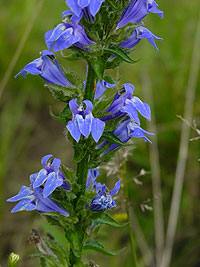Culture
Prefers moist organically rich soil in shady to sunny areas. Tolerates drier locations than L. cardinalis, but insists on some afternoon shade in warmer zones. Propagate by seed, division or cuttings. May self seed. Best used as a border, wild, hummingbird, butterfly and water gardens. Also to add color to woodland gardens.
Container Cultivation
Grow in a moisture-retaining mix or standard mix in full sun or light shade. Keep evenly moist for best results. Responds well to fertilizer, but can get very tall if given plenty of nitrogen. An early season (May/June) cut back keeps it shorter and fuller.
Great Lobelia, the blue counterpart of the Cardinal Flower, can be found in open, moist places and blooms at the same time as Cardinal Flower. The Latin species name indicates that it was once thought that Great Lobelia was a cure for syphilis. The Native Americans of this region used Lobelia as an analgesic and as a treatment for many other common ailments.

Great lobelia typically grows in moist to wet locations along streams, sloughs, springs, swamps, meadows and in low wooded areas. A clump-forming perennial which features light to dark blue, tubular, 2-lipped flowers with the three lobes of the lower lip appearing more prominent than the two lobes of the upper lip. Flowers arise from the upper leaf axils forming a dense terminal raceme atop stiff, unbranched, leafy stalks typically rising 2-3' tall. Finely-toothed, lance-shaped, light green leaves (to 5" long). Late summer bloom period. Species name of siphilitica arose from a prior medicinal use of the plant in the treatment of venereal disease. Also sometimes commonly called blue cardinal flower.
 Great Lobelia
Great Lobelia